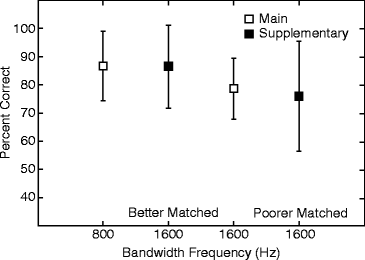Fig. 42.1
Circles and squares show average percent correct for identical- and reflected-spectra, respectively. Vertical lines show plus and minus 1 standard deviation. Abscissa values are offset for clarity
A result that could be seen as being inconsistent with an interpretation in terms of envelope comparisons between the outputs of “matched” peripheral auditory filters is the reduction in performance that occurred at the widest bandwidth for the reflected-spectrum condition. In the identical-spectrum condition, increasing the bandwidth from 800 to 1,600 Hz resulted in larger frequency separations between all corresponding frequency regions of the low and high bands. This would result in more poorly matched auditory filters for all corresponding frequencies in the 1,600-Hz case, which might account for the drop in performance between the 800- and 1,600-Hz bandwidths. In the reflected-spectrum case, band widening from 800 to 1,600 Hz introduces corresponding stimulus components into increasingly mismatched auditory filters, while maintaining stimulation of the more closely matched filters associated with the 800-Hz bandwidth condition. The added frequencies in the 1,600-Hz bandwidth condition would not necessarily hurt the performance if the listener were able to weight information optimally. One possibility is that listeners do not weight information optimally. If this interpretation is valid, better performance in the 1,600-Hz reflected-spectrum condition might occur if cues were present to encourage weighting of the better-matched filters. We attempted to examine this idea in two supplementary conditions.
3.1 Supplementary Conditions
The two supplementary conditions involved reflected-spectrum, 1,600-Hz bandwidth stimuli and used temporal gating manipulations intended to perceptually isolate particular 800-Hz portions of the lower and higher 1,600-Hz-wide bands. In one of the conditions, the aim was to perceptually isolate the better-matched filters associated with the low and high bands. Here, the lower half of the low band and the higher half of the high band were presented continuously, and the higher half of the low band and the lower half of the high band were presented only during the three listening intervals. This gating pattern was intended to promote preferential weighting of the better-matched filters. The complementary condition was also run, where the higher half of the low band and the lower half of the high band were presented continuously, and the lower half of the low band and the higher half of the high band were presented only during the listening intervals. This gating pattern was intended to promote preferential weighting of the more poorly matched filters.
An important feature of the continuous portions of the 1,600-Hz-wide bands is that they were normally random but were comodulated in the signal interval. This was accomplished by gating off the random bands while simultaneously gating on the comodulated bands. Because the total level of the bands was unchanged over time, this transition was “seamless.” The random bands were also gated off in the non-signal listening intervals, with separate random bands simultaneously gated on, in order to insure that the difference across intervals was related to comodulation rather than to an uncontrolled feature related to gating. As in the main experiment, the listening intervals were 400 ms in duration and were separated by 300 ms. All six listeners from the main experiment completed data collection for these conditions. Assuming that the gating manipulations resulted in the intended effects, we had the following expectations for the supplementary conditions when compared to the 800-Hz and 1,600-Hz reflected-spectrum conditions of the main experiment: (1) performance for the 1,600-Hz bandwidth supplementary condition with gating intended to isolate the better-matched filters should be similar to that for the 800-Hz bandwidth condition from the main experiment; (2) performance for the 1,600-Hz bandwidth supplementary condition with gating intended to isolate the better-matched filters should be better than that for the 1,600-Hz bandwidth condition from the main experiment; and (3) performance for the 1,600-Hz bandwidth condition from the main experiment should be better than that for the 1,600-Hz bandwidth supplementary condition with gating intended to isolate the more poorly matched filters.
Figure 42.2 shows the results of these four conditions, plotted in order of expected performance. As can be seen, some aspects of the findings were consistent with expectations. A repeated-measures ANOVA was performed to compare the four reflected-spectrum conditions shown in Fig. 42.2. In the analysis, the conditions were ordered by expected performance. This analysis showed a significant effect of condition (F 1,5 = 7.47; p = 0.003). Planned contrasts between adjacent conditions indicated:


Fig. 42.2




Percent correct for the 800- and 1,600-Hz reflected-spectrum stimuli of the main experiment and for the two supplementary 1,600-Hz reflected-spectrum stimuli. Gating in the supplementary conditions was intended to isolate either the better or more poorly matched auditory filters. Vertical lines show plus and minus 1 standard deviation
Stay updated, free articles. Join our Telegram channel

Full access? Get Clinical Tree


